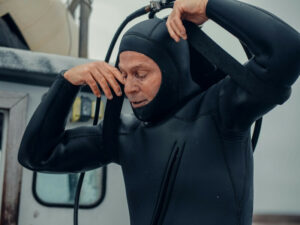Do you know how clothes keep you warm in cold weather? Body heat warms the trapped air and reduces the heat gradient between your body and the environment. But how does a wetsuit keep you warm? Wetsuits are no different from the clothes you wear every day.
A wetsuit is a tight-fitting garment worn to provide thermal protection (keep the body warm) while in the water. It is used for water sports activities such as diving, surfing, swimming, windsurfing, scuba diving, jet skiing, water rafting, and so on.
Key Takeaways:
- Why it is so crucial to wear something warm when you go diving
- How the warmth of your wetsuit is linked to the thickness of it’s material and how it can keep the warmth underwater
- What you can do if you still get cold underwater
Why do you feel cold while surfing or diving?
When you dive underwater, the temperature drops with every meter you go deeper below the surface of the ocean. This temperature is not exactly conducive to the human body. Therefore, it is essential to keep your body warm when you are underwater for a long time.
Wetsuits are primarily designed for divers, swimmers and scuba divers to keep their bodies warm in the water. If you don’t wear a wetsuit, your body will start to shiver after just a few minutes due to the cold water, because your body loses heat and energy faster in the water than through the air.
That means that this happens much faster in cold water than in warm water. The wetsuit acts like a thin layer between your skin and the cold water, insulating the heat and keeping you warm even in deeper levels.
Wetsuits are not designed to dry you out completely. That means they can keep you comfortably warm longer while surfing, diving or swimming. But they do not protect you 100% from heat loss or hypothermia.
Warmth depends on the thickness of the wetsuit
Insulation depends on the thickness of the neoprene and water temp range the diver can tolerate. The neoprene rubber of a thicker wetsuit will accumulate more heat. It is important to be aware of the water temperatures in which you will normally wear your wetsuit (taking into account the different seasons and surf) to be able to take them into consideration when choosing your wetsuit thickness.
Use the chart below to determine the thickness and ideal wetsuit type for each water temperature or read the wetsuit thickness and temperature guide.
| Water temperature(Fahrenheit) | Wetsuit Thickness | Recommended wetsuit type (and accessories) | Seal type |
| Below 42 | 6/5 mm | Full suit + Boots + Gloves + Hood | Sealed and taped |
| 43 to 52 | 5/4 mm | Full suit + Boots + Gloves + Hood | Sealed and taped |
| 52 to 58 | 4/3 mm | Full suit + Boots + Gloves + Hood | Sealed and taped |
| 58 to 63 | 3/2 mm | Full suit + Boots + Gloves + Hood | Sealed |
| 62 to 68 | 0.5 mm to 2 mm | Springsuit/ Fullsuit | Flatlock |
| 65 to 75 | Top / Shorty | Flatlock | |
| Above 75 | Rashguard for skin and sun protection | Flatlock |
How does neoprene keep you warm?
As mentioned the number one material for cold weather wetsuits is neoprene. Wetsuits work by trapping a thin layer of warm water between your body and the suit. This prevents you from losing too much heat in the water because the element water conducts heat away from your body 25 times faster than air because it has a higher density. Therefore, water has a greater heat capacity than air.
For example, if you are wearing pants and a shirt outside on a 60-degree day, you will undoubtedly be comfortable, but if you are swimming in the same water, you will probably shiver within minutes. Energy flows much faster from your hand into the cold water.
How warm do wetsuits keep you?
You either dive into the water from a boat platform or go into the sea wearing a wetsuit. After the cold seawater penetrates the wetsuit, you feel it on your skin for only a few minutes. However, the warm water will gradually reach your body temperature so that you can stay warm inside your neoprene wetsuit.
A lightweight long wetsuit will keep the surfer warm and comfortable up to a water temperature of 58 degrees Fahrenheit. Below this temperature, a thicker neoprene wetsuit should be used.
Wetsuit Fit: Tightly fitted wetsuit vs. Baggy wetsuit
A wetsuit should be a form-fitting garment that gently constricts you. A very thin layer of water is trapped between your skin and the wetsuit once you enter the water keeps warm at your body temperature. If the wetsuit is too tight, a lot of cold water will penetrate and fill the spaces between the wetsuit and your body. In the first and second case, your body immediately becomes cooler when cold water enters it.
What happens with a baggy wetsuit:
With a baggy wetsuit, substantially more water will initially be inside the suit. It will take considerably longer for your body to warm up, and a lot of heat will be lost in the process.
Fresh water will quickly rush through the suit as you are submerged in water and begin to move around, diluting the water that your body worked so hard to warm. It will be difficult to retain much body heat. Thus, continuous flushing of cold water will also significantly lower the wetsuit’s efficiency.
My wetsuit is too tight-fitting:
Here, your body heat warms the thin layer of cold water that seeps through the suit. It warms up quickly because there is not much water. Also, not much heat is extracted from your body. Since the suit is already filled, no extra water gets into it as you move around in the water.
How much warmer does a wetsuit make you?
In summary, a baggy wetsuit cannot keep you warm because it is too loose at the ankles, neck and wrists. On the other hand, a tight-fitting wetsuit will prevent fresh water from entering the wetsuit.
Also, a wetsuit tends to stretch when you wear it over and over in the water. It gradually becomes looser. The more cold water penetrates your body, the more it displaces the warm water and the colder you feel. So avoid buying a loose and baggy wetsuit. A thin and tight fitting wetsuit will allow less water to penetrate the wetsuit.
Read this article about the wetsuit size chart to find your fitting wetsuit size.
Wetsuit Length
Wetsuit length is crucial for a good fit. Follow the following tips when trying on different wetsuit sizes to find your perfect fit:
- It’s okay if the suit is longer. But it should not be too short.
- If you are buying a wetsuit for the first time, measure your current dress size. Then go through the wetsuit chart provided by the brand and compare it to your body measurements to determine the ideal fit.
- It should be snug around the torso, neck, shoulders, knees and legs, but at the same time comfortable to wear.
- No wrinkles should be visible except under the armpits.
- Try out the fit of the wetsuit through various movements such as twisting, bending, stretching and paddling.
- If there is too much resistance when wearing the wetsuit, the wetsuit is too tight.
- Protectors should fit appropriately and tightly at the knees.
- Since wetsuit boots fit tighter than the normal size, you should round down to the closest size.
- If you are wavering between two sizes, always choose the larger one.
- Extra-tip for women: The wetsuit should not have a gap or hole in the back to ensure a snug fit. This is because women have a more curved lower back.
Other Details you should take care of:
- Consider boots, neoprene gloves and hoods if the weather is cold enough to cause extreme numbness.
- Also, pour warm water into your wetsuit before surfing or diving in cold water. This will keep you warm.
- Choose a wetsuit with the right thickness and material considering the water conditions, water sport, air temperature, your cold tolerance, etc.
How to get extra warmth while wearing a wetsuit?
There are some things you can do to keep yourself extra warm underwater, especially if you are one of those people who gets cold very quickly.
Get yourself a smaller wetsuit
A shorter wetsuit will help to warm up the trapped water faster and reduce the speed at which it loses heat. Also, it will allow the least amount of water to enter your wetsuit.
Keep yourself extra warm before surfing
You can consider wearing leggings, T-shirts, etc before getting into the water. If you live in a colder climate or are diving in colder water, layer up even more. If you keep yourself warm before diving or surfing, you feel less cold when in the water.
Eat a lot of healthy food
You will be warm as your body generates heat to digest the food. Also, it will provide you with energy for your next surfing or diving session.
Do not pee in your wetsuit
Even if it might sound amusing, but when the urine is flushed out of your wetsuit, it will get replaced again with cold water. Your body will lose heat, and you will start feeling cold quickly.
Pour warm water into your wetsuit
When you first enter cold water, your wetsuit will fill with ice-cold water. Fill a Hydro Flask to pour the warm water into your wetsuit. You may also immerse your boots, gloves, and hood in warm water before putting them on. It will provide you with extra warmth.
Conclusion: staying warm is a question of the right wetsuit thickness and preparation
The wetsuit acts like a thin layer between your skin and the cold water, insulating the heat and keeping you warm even in deeper levels. The number one material for cold weather wetsuits is neoprene, because it works by trapping a thin layer of warm water between your body and the suit, keeping your warm body at the same body temperature.
Make sure that you find the right thickness and fit of your wetsuit, because these are crucial factors for staying warm and protected underwater. The choice of the thickness depends on what kind of climate and sea you are diving in and what resilience to cold you have.
FAQ to how does a wetsuit keep you warm?
The secret behind wetsuits’ reliability and functionality is in the material called neoprene, a synthetic rubber that gives great flexibility as well as providing insulation against cold temperatures and water, making it a piece of useful garment for divers and surfers who like to do their things in cold aquatic …
The myth is this: Wetsuits keep you warm by trapping a thin layer of water between your skin and the suit. This is incorrect. A wetsuit that is bone-dry on the inside will actually be warmer than one that’s wet.
Wetsuits are made of a kind of rubber called neoprene. The suit traps a thin layer of water between the neoprene and the wearer’s skin. So, the wearer is always wet—that’s why it’s called a wetsuit. Body heat warms the layer of trapped water and helps keep the wearer warm.









